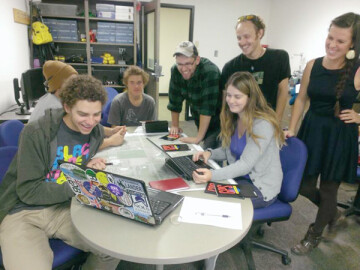Service Learning 101
MSU Student Maps Help Save Lives
Danielle Martin | Tuesday Sep. 30th, 2014
Most people don’t often consider how long it takes a fire truck to reach their front door once they’ve called 911. What almost no one considers is how those emergency personnel can even find your front door in a high density building.
“The difficulty is accentuated by the fact that, in these high-density housing developments, building numbers are often arranged in an illogical manner.” said Diana Cooksey spatial sciences instructor at Montana State University.
The answer to this fundamental problem is found in the maps carried in fire engines and integrated into the Enhanced-911 (E-911) computer system. In the world of fire fighting response times are everything, where mere seconds can mean life or death and losing everything you own.
“These maps are in all Bozeman Fire Department’s front-line apparatus. The information gets used on an almost daily basis to shave seconds or more off our emergency responses to these difficult areas” writes Bozeman Firefighter Nate Bashkirew in a letter of recommendation for the E-911 program.
With the explosive growth of the Bozeman community over the last decade it’s been hard for the fire department maps to keep up. This is where Cooksey, and her MSU global positioning system (GPS) students enter the equation.
Teaming up with the City of Bozeman and the Bozeman Fire Department Cooksey has been able to create a program that allows students to gain hands on experience while serving the community.
Cooksey’s spark of inspiration came when one of her GPS students decided to map the large trailer park he lived in so that pizza could be delivered faster to his front door.
Cooksey was grading the project when her husband, a veteran fire fighter, saw the map and said “wow, we could really use this at the fire Department!”
This kind of neighborhood specific, easy to read map was exactly what was missing from their fire department map books. From there conversations with the stakeholders began.
Areas in special need of mapping are identified by the City of Bozeman Geographic Information Systems (GIS) department. Once each student is assigned a property they take Cooksey’s professional grade GPS receivers out into the field where they record positions for various features that matter a lot to emergency personnel; like entryways to parking lots and buildings, fire hydrants, and gas shut offs.
While it may seem daunting or even unreasonable to ask students brand new to a technology and software to create professional grade maps, Cooksey’s students are up to the task.
Ethan Schreuder a Fall 2013 program participant said “The project is hard but very rewarding, you get to work on a real world problem, with professionals, using really expensive equipment, and the reward far outweighs the challenges.”
When reflecting on the program her former students wrote: “It gave us students a great opportunity to gain some hands on experience and create work that will be viewed and used by professionals rather than just being graded and tossed in a pile” and “In short it is the most worthwhile school project I have ever done.”
Last semester eight students decided to map something different than a condo complex, or apartment building and collaborated to take on the challenge of mapping the Bobcat Stadium property.
“At the beginning of the project, I thought we were going to be working on separate properties, but I got really interested in Bobcat Stadium. Since the stadium was such a large piece of property, we all decided to work on that” Schreuder said.
Once the data is collected the students are tasked with creating a map with it using GIS software, in order to be a part of the program students must already be proficient in this software.
The map and the new data are then given to Jon Henderson of the City of Bozeman GIS department who will add them to the E-911 System making them accessible to all Bozeman fire engines.
“The E-911 system links an address and a set of GPS coordinates to every telephone number, so that, when a person calls 911, the dispatch center automatically receives this information” said Cooksey.
This program, which won the 2014 President’s Award for Excellence in Service Learning, has proven to be “both a benefit to the community and as a powerful tool to help motivate students to do their best” according to the MSU News Service. The program also won the 2005 International Association of Fire Chiefs Fire Service Award for Excellence.
Henderson wrote in his letter of recommendation for the President’s Award “We are confident that the citizens of Bozeman directly benefit from this efficient and effective use of value-added information. The Department of Land Resources & Environmental Sciences (Diana Cooksey, in particular), should be recognized for their commitment to helping make Bozeman “The Most Livable Place”.
Unlike most participants, the Fall 2013 students got to see their map in action while at the 2013 Cat-Griz football game in November. Ethan Schreuder saw the map he made on a gurney of an AMR ambulance.
“That part was especially rewarding” he said “it was nice to know that it was already being used.”
When asked, everyone involved said they want to see the program continue far into the future. Bashkirew wrote enthusiastically “the fire department views this partnership as a shining success and looks forward to continued collaboration in the future!!”
| Tweet |
